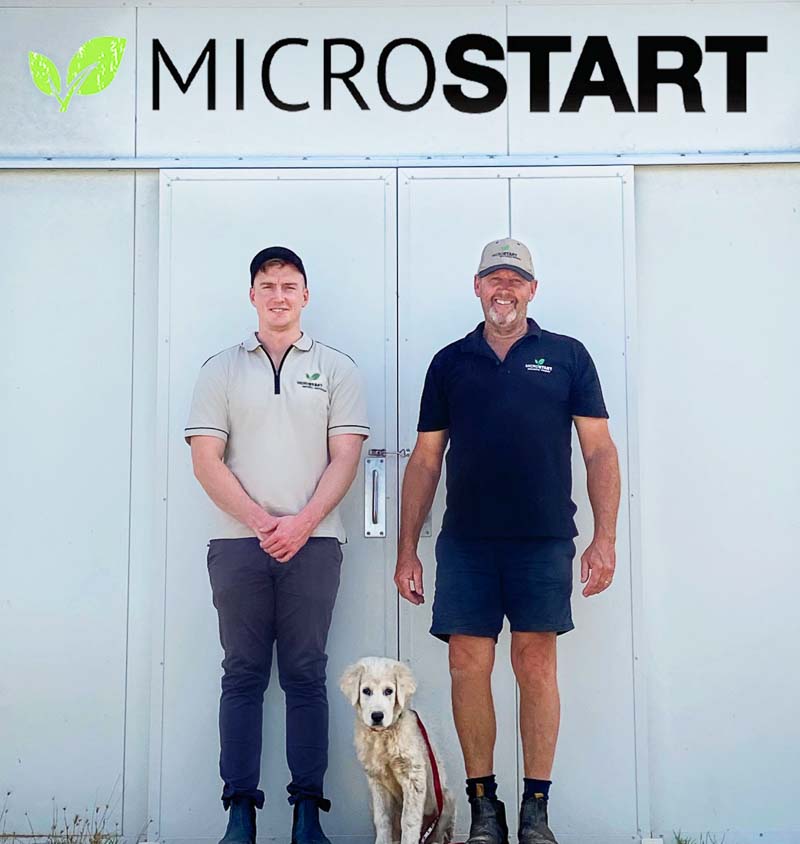 Darren and his son Ryan are passionate about working with farmers to rebuild their land's natural biological systems.
Darren and his son Ryan are passionate about working with farmers to rebuild their land's natural biological systems.
Darren Kuchel walks farmers through these transitions on a regular basis. His company, Microstart Farming, was born when he made the transition himself. After developing a recipe for a biological input to kickstart the natural processes of his soil, Darren's friends and neighbours began noticing the positive changes on his property. Over time, more and more began asking to buy his magical bio-brew.
After working closely with world-renowned soil and plant biologist Dr Mary Cole to perfect his biological application, Microstart Farming was born.
Today, Darren's Liquid Microbe Agriculture Mix is just one part of the business. Darren and his son Ryan are passionate about working with farmers to rebuild their land's natural biological systems. They make specific adjustments to each mix based on the soil type, pasture type, location and farming practices to help their clients achieve optimum results.
After two decades of working with landowners all over Australia, Darren has become something of a guru on how to break the synthetic-input dependency cycle for good.
Here's his advice for farmers ready to take the leap, or rather, gradually transition, to natural inputs and systems:
Weaning the land off synthetic inputs
Many conservative naysayers are using the agricultural crisis in Sri Lanka as an example of why farmers should stick to conventional agricultural systems. However, this nationwide crisis is not a result of what they did; more so, it was how they did it.
In 2022, the island nation lurched towards famine after synthetic fertiliser and pesticide inputs were practically banned overnight in September 2021. This agrochemical ban contributed to a nationwide fall of 30% in rice production and a drop of 18% in the country's largest export, tea (De Guzman 2022). The Sri Lankan experience was a sober warning for a world increasingly interested in synthetic-free pathways, but with billions of hungry mouths still to feed.
The transition from conventional to regenerative must be strategic and nuanced for farmers to maintain or see an increase in productivity throughout the transition period.
The transition from conventional to regenerative, biological or organic must be far more strategic and nuanced for farmers to maintain or even see an increase in productivity throughout the transition period. Darren describes soil and plants that have been farmed under a conventional model as 'on life support'. They are essentially addicted to the synthetic inputs that have been keeping them alive. These inputs address the plant's chemical needs but destroy the soil's structural and biological components, which are essential for nutrient cycling, fertility and natural productivity.
'In a cropping system we recommend that farmers reduce their fertiliser use gradually,' says Darren.
'They might halve the amount for a year, then drop it to a quarter in the next, while simultaneously changing their management practices and introducing biological inputs to rehabilitate and build the soil's natural processes. Depending on the state of the land and soil, this process can sometimes take up to five years. In permanent pastures, the transition can be much more immediate without seeing a loss in productivity.
'The more you wipe out your fungi, the more chemicals become locked up and unavailable to the plant, resulting in a drop of synthetic fertiliser efficacy.
'We often find farmers are seeing their synthetic inputs working much better as they wean off chemicals and re-establish their soil's biological processes. This is because the reemergence of microbial activity is allowing synthetics to become plant-available once again.'
Alternative inputs
It's also important for farmers to consider using natural inputs to kick-start the soil's biological activity.
It's also important for farmers to consider using natural inputs to kick-start the soil's biological activity. This is where biological applications such as composts, compost teas, and seaweed and fish emulsions come in. Darren began brewing his own liquid microbe mix when he witnessed the poor-quality pastures and stock health on his own operation. Today, as well as producing their popular off-the-shelf range, Daren and Ryan tailor custom mixes to fit their clients' needs. They've found that farmers producing primarily annuals will need a higher ratio of bacteria to fungi in their liquid microbe mix. In a pasture scenario, however, fungi are critical, and too much bacteria can actually increase weed load.
When considering a biological application to support your own transition, be sure to speak to an expert who can help identify your soil needs. From there, an appropriate program can be developed.
Management strategies
Critical to any successful transition from synthetic inputs are the management strategies that help support the biological functions of the soil. These look different depending on the type of operation.
Darren believes that the most important management practice for livestock operations is a rotational grazing model.
Darren believes that the most important management practice for livestock operations is a rotational grazing model. The keys to a successful rotational grazing model are; increasing the number of paddocks and reducing paddock size, balancing stocking rate with feed availability, and ensuring adequate rest for pasture. Rotational grazing and incorporating rest will lessen soil compaction, increase water infiltration and allow for the respiration of plant roots and soil organisms.
Darren also recommends introducing multispecies forages. Incorporating a multispecies mix (typically made up of several species from each of the five forage plant families) introduces a variety of root structures and plant functions, all of which boost the beneficial bacteria and fungi in the soil and contribute to nutrient cycling and self-sustaining fertility.
For cropping operations, improving soil structure and encouraging beneficial bacteria and fungi is paramount to reintroducing the natural biological systems.
For cropping operations, improving soil structure and encouraging beneficial bacteria and fungi is paramount to reintroducing the natural biological systems. Some of the management practices that help maintain soil structure include no-till and controlled-traffic systems. These practices dramatically reduce compaction and soil disturbance, which in turn allows soil microbiology (especially fungi) to thrive. Additionally, these practices increase water infiltration and allow for better drought tolerance.
Another way of promoting good soil structure and biology is planting in the stubble. Planting in the stubble and leaving the roots in the ground increases water infiltration and decreases runoff. As the roots left in the ground decay, they feed the microbial life which, again, contributes to the natural process of nutrient cycling and self-sustaining fertility.
Another fantastic way to encourage biological systems is by increasing crop biodiversity as much as possible. This can take the form of crop rotations or companion cropping. Pathogens often thrive in monoculture fields planted out with the same crop season after season; crop rotations can mitigate this risk whilst allowing beneficial microorganisms to thrive. Similarly, companion cropping means that multiple root structures are present in the soil, which feeds and encourages microbial activity.
Finally, for any kind of operation, one of the most important management strategies is keeping the ground covered. Bare ground loses moisture to evaporation quickly. When covered, soil maintains the moisture and humidity needed for the fungi and bacteria to breed and thrive. Depending on the type of operation, ground cover can take the form of cover crops, stubble retention, mulches, green manures, and preserving pasture by time-controlled grazing.
The management strategies listed above are just the tip of the iceberg. Speak to someone like Darren or a local regen expert to identify which will work best for your property and goals.
Results: A self-sustaining system
When a system has been successfully weaned off synthetic inputs and the soil's biological processes have been reestablished, it should be able to sustain itself and create its own fertility. 'Within the first year, you might have a centimetre or two of good topsoil,' says Darren, 'and the next, it might be four centimetres and so on. It works its way down through the profile.'
When the soil biology is in balance, plants are able to derive all the complex nutrients they require from the soil and no further synthetic inputs are required.
When the soil biology is in balance, plants are able to derive all the complex nutrients they require from the soil and no further synthetic inputs are required, which eliminates the ongoing costs of synthetic applications. Once a biological system is well established, the use of any biological applications can also be dialled back significantly.
'Then we see the worms come back,' says Darren.
Worms create burrow networks that mix and oxygenate the soil, improving its structure and allowing for water infiltration. Importantly, a healthy worm population adds to a self-sustaining cycle of fertility. 'Worm castings contain seven times more phosphorus, 10 times more potassium, five times more nitrogen, three times more magnesium and one and a half times more calcium than the surrounding soil,' says Darren. 'And best of all, they work for free!'
One of the tools that farmers can use to monitor the progress and productivity of their pastures is a Brix meter refractometer to measure the increase in sugar content of plants. With increased biological activity in the soil, plants are able to photosynthesise more effectively and produce more sugars in their leaves. This equates to an increase in nutritional value and better stock weight gains and feed efficiency.
One of the tools that farmers can use to monitor the progress and productivity of their pastures is a Brix meter refractometer to measure the increase in sugar content of plants.
The flow-on effects of switching to a biological farming system are endless, and for people like Daren, who have been doing it for years, it's a no-brainer. The key is educating producers on how to transition successfully so that they can maintain profitability whilst their land is undergoing significant changes on its journey to a synthetic-free future.
Farmers looking to learn more about biological farming can download a free copy of The Biological Farming Revolution on the Microstart Farming website. Darren and Ryan created this e-book to provide farmers with in-depth information about how the biological system works in the soil and how best to get started. Alternatively, get in touch with the Microstart team.
De Guzman C (2022) The Crisis in Sri Lanka Rekindles Debate Over Organic Farming, Time, https://time.com/6196570/sri-lanka-crisis-organic-farming/, accessed 30 June 2023.

